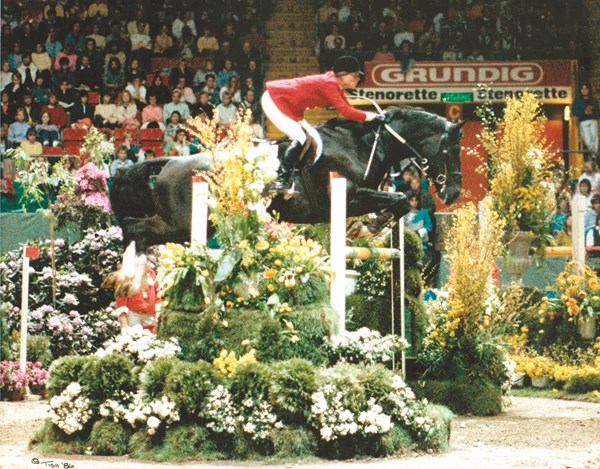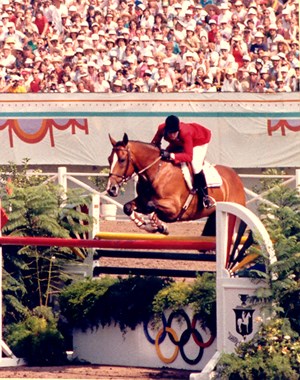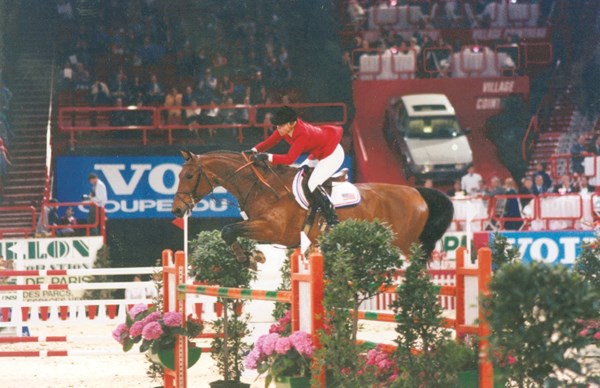It’s like no other jumping championship. At the Longines FEI World Cup™ Jumping Final, March 29–April 2, in Omaha, Nebraska, fans will see three demanding competitions, each building toward the next. The only break is between days two and three, so those trying for the world indoor jumping honors can catch their breath briefly.
In contrast to other multi-day title meets—such as the Pan American Games, the World Equestrian Games or the Olympics, where everyone starts the competition for the individual medals on zero penalties—riders add to their scores throughout the World Cup™ proceedings. The one who stands at the top level of the podium, raising the trophy in triumph, will have done so carrying a total number of penalties accumulated throughout the weekend.
“At the Olympics, you can have a bad day as long as you make it to the finals,” observed Leslie Howard, the winner of the 1986 World Cup™ Final on McLain.
But not at the World Cup™. So it takes a horse of special character and other traits, as well as exceptional athletic ability, to win a FEI World Cup™ Jumping Final when every fence counts.
“If you don’t do well on the first night, you have no shot. Even if you have a big, scopey horse who can go clear the other nights, you’re not going to catch up,” said former U.S. Show Jumping Coach George Morris.
Someone who isn’t in the top group of four or five in the first day’s demanding speed class over grand prix fences likely doesn’t have the chance for a comeback in the second day’s timed first jump-off class or the final day’s two-rounder.
It has been done, most notably by Michael Matz, who was 11th during the first leg on the great Jet Run in the third World Cup™ in 1981, then went on to claim the prize. But often the winner on the first day is the one who goes on to take the title. That’s the way it happened for Melanie Smith Taylor with Calypso in 1982, Katherine Burdsall Heller with The Natural in 1987 and in 2012 for Rich Fellers with Flexible, who was the first U.S. winner of the title in 25 years.
Careful Jumpers with Stamina
As George pointed out, “catty, indoor-type horses” have the advantage in the speed leg. “Most of them are Thoroughbred types, careful,” usually a different kind of horse than could win outdoor scope tests such as Aachen or Calgary, commented George, who worked with a number of World Cup™ Finals winners, among them Katherine, Melanie, Leslie and Meredith Michaels-Beerbaum.
 Leslie Howard and McLain won the 1986 World Cup™ | © Tish Quirk
Leslie Howard and McLain won the 1986 World Cup™ | © Tish QuirkSome riders compete on one horse in the speed class, then switch to another for the next two.
As Leslie noted, being able to change mounts, for those who have the horsepower, “does really make it a very different event” from other championships.
But Meredith had no need to do that with her “so exceptional” Shutterfly, who won three World Cup™ Finals and was second in another.
One of his assets was “the fact that he had stamina; he was not a horse who would get tired. The World Cup™ Final has a lot of rounds in a short amount of time, [it ’s] intense jumping,” said the veteran of many German teams.
In what she called her “most perfect” World Cup™ victory in Las Vegas eight years ago, Meredith had the crowd going wild as she left out a stride to a double on an inside turn, yet she was able to add a stride in a line where she needed to as she won the speed segment.
“He was so agile, he could put little strides in and jump from almost no impulsion. He was able to turn quick and jump from what looked basically like a standstill,” Meredith recalled.
She noted that the relatively small ring in Las Vegas therefore suited him well (he won there in both 2005 and 2009), but as she mentioned, “he could come back the next day and not lose his cool, not get flat and jump a big track clear. And then once again in the jump-off, he showed his speed and turning ability. For the Final on Sunday, he always had enough left in the tank because he had endless energy and stamina and could do the two rounds without even breaking a sweat.”
When the Final rolls around, there is always talk about the importance of having an “indoor horse” as opposed to an “outdoor horse.”
 Melanie Smith Taylor described her 1982 World Cup™ champion Calypso as a tenacious fighter who had heart and a competitive desire to win | © Tish Quirk
Melanie Smith Taylor described her 1982 World Cup™ champion Calypso as a tenacious fighter who had heart and a competitive desire to win | © Tish QuirkMelanie doesn’t use those terms. “I think a great horse is a great horse, and they can show in any venue. But that’s from my experience,” she said, while noting she doesn’t compete anymore.
“How is riding indoors different from a tight jump-off course anywhere? It’s being able to land and immediately focus on the next jump and be able to jump quickly. It suits certain horses; it suits great horses,” she declared, though she did concede that a big, gangly horse might not be at his best indoors.
Sound Body and Sound Mind
What else is required to win the Longines FEI World Cup™ Final?
“It always takes a sound horse when you have a championship for any period of days. Physical soreness affects the horse mentally,” Melanie said.
In addition, she mentioned, a lot of horses may not be comfortable indoors with the crowd generally closer to them than it is outdoors. With Calypso, however, it was just the opposite.
“The louder the crowd, the more he rose to the occasion. It would lift him up, he became more of a fighter. They have that desire to win. You want your horse to win as badly as you do,” Melanie continued. For a tenacious rider, “You want your horse to feel that tenacity. Horses have to be born with heart. Heart is what gives them competitive spirit and the desire to be careful.”
As Rich noted, “The character of any athlete, human or equine, is so important.” Speaking of Flexible, who has bounced back from several serious injuries, he cited the stallion’s “unique character. He’s a sensitive horse, but he’s tough at the same time. That gives him, at the end of the day, the end of the week, the end of the course, a little more fight than maybe a more mild-mannered horse.”
The Natural always rose to the important occasion, such as the Final that he won in Paris. “He could sense when it was a big day or a big event,” Katherine recollected.
 Katherine Burdsall Heller recalls how The Natural, who won the Final in 1987, would rise to the occasion during important shows. “He could sense when it was a big day or a big event,” she said | © Tish Quirk
Katherine Burdsall Heller recalls how The Natural, who won the Final in 1987, would rise to the occasion during important shows. “He could sense when it was a big day or a big event,” she said | © Tish Quirk“He was very sensitive, but he was also pretty level-headed. Consistency is a big thing in those kinds of championships. They’ve got to come out on the first day and be ready to take the pressure.”
Even going indoors, when he had been competing outdoors, didn’t faze him. “He was pretty adaptable,” Katherine said, citing another trait that is important for success in the Final.
Strategy also plays a role in winning, as Rich mentioned. “When I get to the World Cup™ Final, I try to make a plan that I feel is competitive and, at the same time, very possibly [would] yield a clear round—and that really comes into play when speed is involved. You have to know your horse and how much you can ask for just to stay within that comfort zone for that horse to end up with a clear. If you take too many risks and have one down, it takes a big toll on your end result.”
 Flexible, who won in 2012 with Rich Fellers, is a tough but sensitive stallion who does well at indoor shows. “The bigger the crowd and the closer they are, the more fired up he is,” said Rich | © Pierre Costabadie/Arnd.nl
Flexible, who won in 2012 with Rich Fellers, is a tough but sensitive stallion who does well at indoor shows. “The bigger the crowd and the closer they are, the more fired up he is,” said Rich | © Pierre Costabadie/Arnd.nlLike Calypso, Flexible does well with the closeness of the crowd at an indoor venue. Rich recalled that when a tent went up for “indoor” competition at the HITS circuit in Thermal, California, a few years back, “the first time he went in that tent, he was lit like a firecracker. He was jumping out of his jeans. The bigger the crowd and the closer they are, the more fired up he is.”
Evolution of the World Cup
Like everything else, the World Cup™ has changed with the times since its inception in 1979, noted Leslie, who is also an Olympic team gold and silver medalist.
“I think that these days the material [used to build courses] is different; it’s lighter, and in the old days, you didn’t have breakaway cups.”
Contrasting what things were like for her victory in 1986, as opposed to the last time she competed in a Final in 2014, Leslie said, “I think the heights were about the same. Gothenburg that year [1986] was huge, but it wasn’t as ‘careful.’ The horses today have evolved. They are as scopey and more careful. I think a lot of that has to do with the breakaway cups, the cups being so shallow and the rails being lighter.”
Ever since Bert de Némethy designed the 1984 Olympic courses, jumper routes have become more technical, said Leslie, citing that as the beginning of modern course design.
“I think there are more good course designers now,” she added, noting that during much of the 1980s, there were only a handful of really good course designers, a number which has more than tripled since then. With education and raising requirements for certification, the FEI (International Equestrian Federation) has ensured “that the knowledge and level of course designing has gotten to quite a high standard,” she observed.










